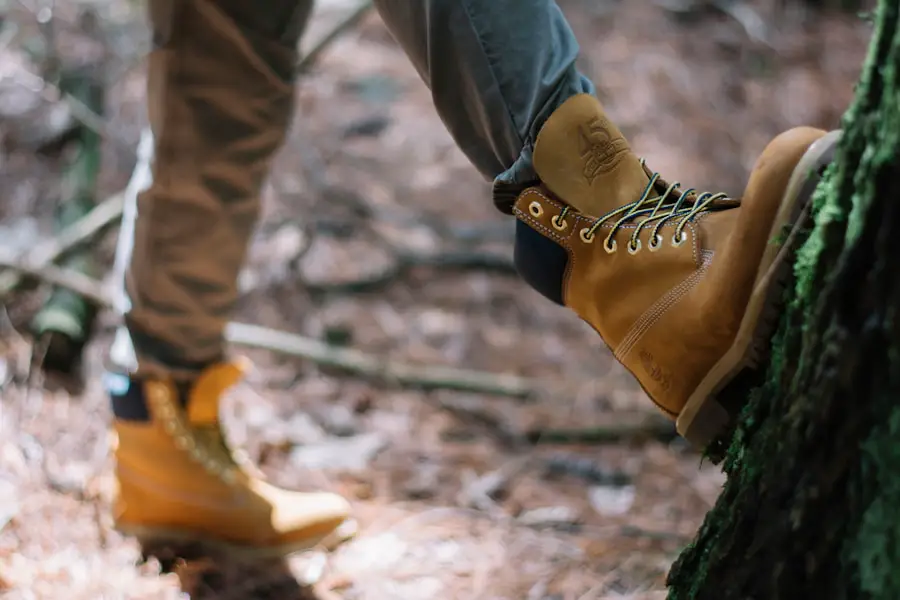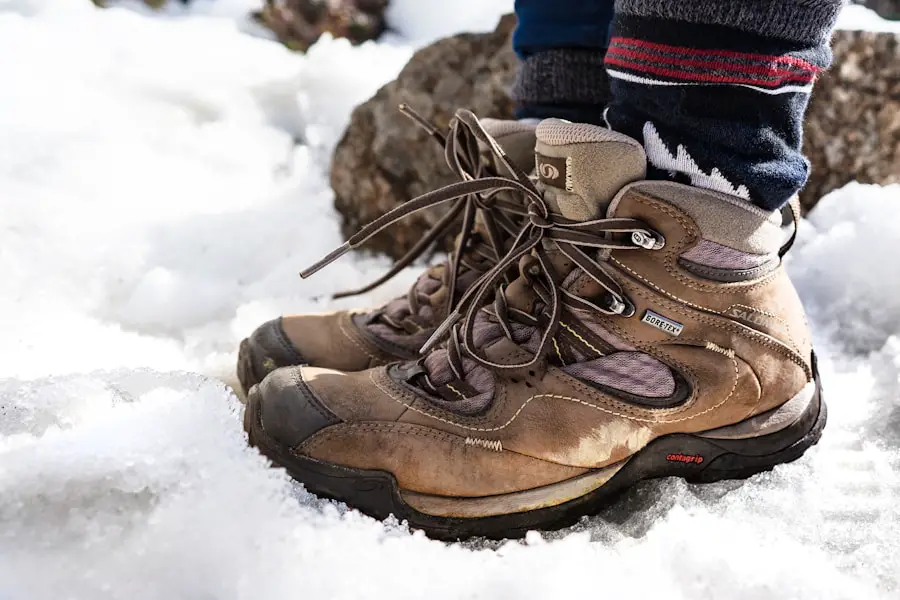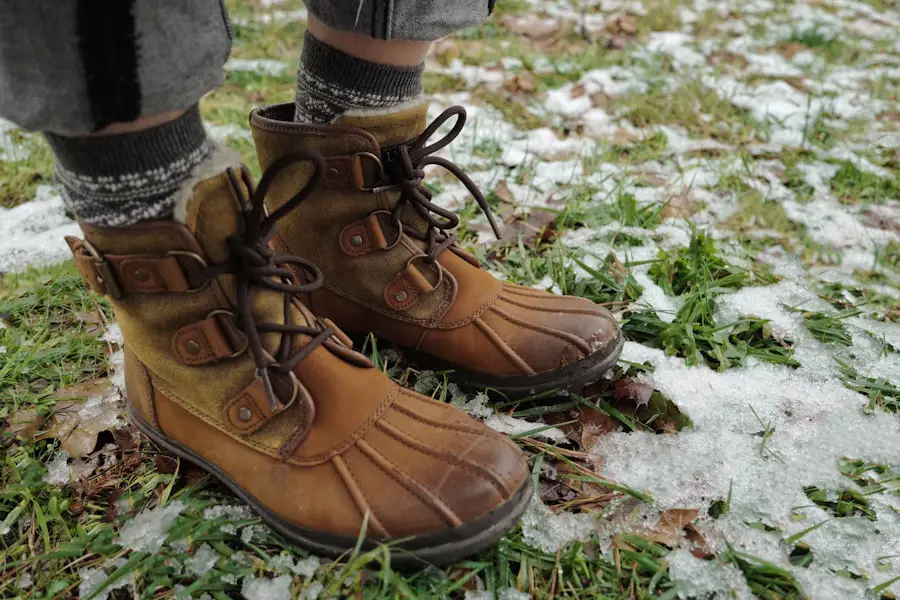Selecting the appropriate hiking boot is a critical first step in ensuring a successful outdoor adventure. The type of terrain you plan to traverse plays a significant role in determining the best footwear for your needs. For instance, if you are planning to hike on well-maintained trails, a lightweight hiking shoe or a low-cut boot may suffice.
These options provide adequate support and comfort without the bulk of heavier boots. Conversely, if your journey involves rugged, uneven terrain or extended backpacking trips, a mid- to high-cut boot with robust ankle support and a durable sole is essential. These boots are designed to protect your feet from rocks and roots while providing stability on challenging paths.
Additionally, consider the weather conditions you may encounter during your hike. Waterproof boots are invaluable in wet or muddy environments, as they keep your feet dry and comfortable. Look for materials like Gore-Tex or other breathable waterproof membranes that allow moisture to escape while preventing water from entering.
On the other hand, if you anticipate hiking in hot, dry conditions, a well-ventilated boot made from mesh or lightweight synthetic materials can help keep your feet cool. Ultimately, the right hiking boot should align with both the terrain and climate of your adventure, ensuring that you are well-equipped for whatever nature throws your way.
Key Takeaways
- Choose hiking boots based on the type of adventure and terrain you will be tackling
- Properly fitting hiking boots are essential for comfort, support, and preventing injuries
- Break in your hiking boots gradually to avoid discomfort and blisters on the trail
- Select the best pair of socks for hiking to prevent blisters and provide cushioning
- Use proper lacing techniques to maximize support and prevent foot fatigue while hiking
Properly Fitting Your Hiking Boots for Comfort and Support
Once you have selected the right type of hiking boot, the next crucial step is ensuring a proper fit. A well-fitted boot is essential for comfort and support during long hikes. When trying on boots, it is advisable to do so at the end of the day when your feet are slightly swollen from daily activities.
This will give you a more accurate representation of how the boots will feel during extended wear. Start by wearing the socks you intend to use while hiking, as this can significantly affect the fit. When lacing up the boots, ensure that there is enough room in the toe box; you should be able to wiggle your toes comfortably without feeling cramped.
In addition to toe space, pay attention to the heel area. A good hiking boot should hold your heel securely in place without causing any slippage. If your heel lifts while walking, it can lead to blisters and discomfort over time.
To test this, walk around the store or on an inclined surface to see how the boots perform under movement. Furthermore, consider the arch support provided by the boot; individuals with flat feet may require additional arch support or custom insoles to prevent fatigue and discomfort during long hikes. A proper fit not only enhances comfort but also reduces the risk of injuries, allowing you to focus on enjoying your outdoor experience.
Breaking in Your Hiking Boots for Long-Term Use

After acquiring a new pair of hiking boots, it is essential to break them in before embarking on a lengthy trek. New boots can often feel stiff and uncomfortable, leading to blisters and soreness if worn for extended periods without proper acclimatization. The breaking-in process allows the materials to soften and conform to the unique shape of your feet, enhancing overall comfort and performance.
Start by wearing your boots around the house or during short walks to gradually introduce them to your feet. This initial phase should last several days, allowing you to assess any pressure points or areas that may require adjustment. As you become more comfortable with your boots, consider taking them on short hikes or walks on varied terrain.
This will help simulate the conditions you will encounter on longer hikes while allowing you to identify any potential issues with fit or support. Pay attention to how your feet feel during these outings; if you notice any discomfort or hotspots developing, it may be necessary to adjust your lacing technique or consider using different socks. The goal is to ensure that your boots are fully broken in before tackling more challenging trails, as this will significantly enhance your overall hiking experience.
Socks Matter: Selecting the Best Pair for Hiking
| Sock Material | Merino Wool | Synthetic | Cotton |
|---|---|---|---|
| Moisture Wicking | High | High | Low |
| Insulation | High | Low | Low |
| Durability | High | Medium | Low |
| Odor Resistance | High | Medium | Low |
While many hikers focus primarily on their boots, the choice of socks is equally important in achieving comfort and preventing foot issues during hikes. The right pair of socks can enhance moisture management, provide cushioning, and reduce friction against the skin. When selecting hiking socks, opt for materials that wick moisture away from your feet, such as merino wool or synthetic blends.
Merino wool is particularly favored for its natural moisture-wicking properties and ability to regulate temperature, keeping feet warm in cold conditions and cool in warmer weather. In addition to material, consider the thickness of the socks based on the type of hiking boots you are using. Thicker socks can provide additional cushioning and warmth but may also lead to a tighter fit within your boots.
Conversely, thinner socks may be more suitable for lightweight shoes but could lack sufficient padding for longer hikes. It’s essential to strike a balance between comfort and fit; ensure that your socks do not bunch up or slide down during your hike, as this can lead to blisters and discomfort. Ultimately, investing in high-quality hiking socks tailored to your specific needs will significantly enhance your overall hiking experience.
Techniques for Lacing Your Hiking Boots for Maximum Support
Proper lacing techniques can make a significant difference in how your hiking boots perform during treks. The way you lace your boots can affect not only comfort but also ankle support and stability on uneven terrain. One common technique is the “heel lock” method, which helps secure the heel in place and prevents slippage.
To achieve this, lace your boots normally until you reach the last two eyelets. Instead of crossing the laces over each other at this point, thread each lace through its corresponding eyelet on the opposite side before pulling them tight and tying them off. This creates a locking effect that keeps your heel firmly in place.
Another useful lacing technique involves adjusting tension based on specific areas of your foot. For instance, if you experience pressure points or discomfort in certain areas, consider loosening or tightening specific sections of laces accordingly. This customization allows for a more personalized fit that can accommodate individual foot shapes and preferences.
Additionally, using lace locks or elastic laces can provide added convenience and security during hikes, ensuring that your boots remain snug without constant readjustment. By mastering these lacing techniques, you can enhance both comfort and performance on the trail.
Maintaining and Cleaning Your Hiking Boots for Durability

To ensure that your hiking boots remain in optimal condition for years to come, regular maintenance and cleaning are essential practices that every hiker should adopt. After each hike, take a moment to inspect your boots for any signs of wear or damage. Remove any dirt or debris from the soles and upper materials using a soft brush or cloth; this prevents buildup that could compromise the integrity of the materials over time.
If your boots are waterproof, it’s crucial to clean them with appropriate products designed for waterproof footwear to maintain their protective qualities. In addition to regular cleaning, consider applying a suitable waterproofing treatment periodically, especially if you frequently hike in wet conditions. This treatment helps restore water repellency and protects against moisture penetration.
Furthermore, allow your boots to dry naturally after each use; avoid placing them near direct heat sources as this can cause materials to crack or warp. Storing your boots in a cool, dry place with proper ventilation will also help prevent mold and mildew growth. By committing to these maintenance practices, you can extend the lifespan of your hiking boots and ensure they remain reliable companions on all your adventures.
Knowing When to Replace Your Hiking Boots for Safety
Even with diligent care and maintenance, there comes a time when every pair of hiking boots must be replaced due to wear and tear. Recognizing when it’s time for a new pair is crucial for ensuring safety on the trail. One of the most obvious signs is visible damage such as cracks in the sole or upper materials, which can compromise support and protection during hikes.
Additionally, if you notice significant loss of tread on the soles or if they feel excessively worn down, it’s time to consider investing in a new pair. Another indicator that replacement is necessary is discomfort during hikes that was not present when the boots were new. If you find yourself developing blisters or experiencing foot fatigue more quickly than before, it may be due to diminished cushioning or support within the boot structure.
Regularly assessing both the physical condition of your boots and how they feel during use will help you make informed decisions about when it’s time for an upgrade. Prioritizing safety by replacing worn-out footwear ensures that you can continue enjoying outdoor adventures without unnecessary risk.
Tips for Preventing and Treating Blisters and Hotspots while Hiking
Blisters and hotspots are common nuisances that can quickly turn an enjoyable hike into an uncomfortable experience. Prevention is key; one effective strategy is to ensure that both your boots and socks fit properly as discussed earlier. Additionally, applying blister prevention products such as blister pads or specialized blister prevention tape can provide an extra layer of protection against friction in vulnerable areas of your feet.
During hikes, take regular breaks to check for any developing hotspots before they escalate into blisters. If you notice any discomfort, consider adjusting your lacing technique or changing socks if they become damp from sweat or moisture. In case a blister does form despite preventive measures, it’s essential to treat it properly to avoid infection.
Clean the area gently with soap and water before applying an antibiotic ointment and covering it with a sterile bandage or blister pad designed for protection during physical activity. By being proactive about prevention and knowing how to treat blisters effectively, you can minimize their impact on your hiking experience and continue enjoying nature’s beauty without interruption.
If you’re planning a hiking trip, it’s important to know how to properly wear hiking boots to ensure a comfortable and safe experience. One helpful article to check out is this guide on the best travel fishing rods, which can provide additional tips on packing efficiently for outdoor adventures. Remember, having the right gear, including a reliable pair of hiking boots, can make all the difference in your hiking experience.
FAQs
What are the best socks to wear with hiking boots?
The best socks to wear with hiking boots are moisture-wicking and cushioned socks made of merino wool or synthetic materials. These socks help prevent blisters and keep your feet dry and comfortable during long hikes.
How should hiking boots fit?
Hiking boots should fit snugly around the heel and midfoot, with some room for your toes to wiggle. They should not feel too tight or too loose, and there should be minimal heel slippage when walking.
Should hiking boots be waterproof?
Hiking boots with waterproof membranes, such as Gore-Tex, are ideal for hiking in wet conditions or crossing streams. However, non-waterproof boots are also suitable for dry and warm hiking conditions.
How do I break in hiking boots?
To break in hiking boots, wear them around the house or on short walks to gradually mold them to your feet. It’s important to wear the same socks you plan to wear on hikes during the break-in process.
Can I wear hiking boots for everyday use?
Hiking boots can be worn for everyday use, especially if you live in a rural or outdoor environment. However, they may not be as comfortable or suitable for urban settings compared to casual shoes.
